Crabby and Crabella are without a doubt two of our favorite crustaceans. The last time we had them over, I didn't take a proper picture of them, so I made up for that this time with a nice studio portrait:
For some reason, they look a bit sad. Not sure what that was about; marital problems maybe. They didn't talk about it. In fact, they were very quiet all through dinner.
Anyway, they are a delicious couple and we're always happy to see them, although digging out all that crab meat is a tedious chore.
Tonight we decided to go very simple: shredded crab meat and three different dipping sauces. They were all divine, though I think the lemon garlic butter sauce was my favorite.
The Food (Jhan)
Who doesn't like crab? It's so delicious and except for the cracking part, it's an easy meal to put together. For this dinner I made three dipping sauces and some garlic bread, add a little wine and voila, dinner is served.
The first sauce was a spicy lemon-garlic butter sauce (we used the leftovers as the sauce for our crab and pasta dinner the following night). The butter sauce is just equal parts of olive oil and butter melted together or 1 cube of butter melted, 3 cloves of garlic, about a 1/2 tsp Italian seasoning (crush it in your palm first to bring out the flavors), some Montreal Grill seasoning - a few shakes, about 2 tbsp chopped fresh parsley, 1/4 tsp paprika, 1 tbsp each green onion and chives, Kosher salt, Tabasco to your taste ( 1/2 tsp or so), 1/2 lemon and its zest. Put everything into the food processor just to combine. Sauce should be lumpy.
This sauce is lemony so you may want to add lemon sparingly if you prefer less lemon flavor. (If you use this as a pasta sauce you'll want to put your crab in the sauce and saute for a couple minutes and then add the cooked pasta with a little pasta water, let that reduce a bit and then add fresh parsley, chives and grated Parmesan on top - it's really good this way!)
Our second sauce was a basil aioli. 1/3 cup mayonnaise, 1/3 cup sour cream, 1/2 cup packed chopped basil,1-2 cloves garlic minced,lemon juice to taste, salt and pepper. Mix all, serve well chilled. I really liked this sauce, the basil added an unusual touch. I also used it as a dip the next day for crostini with Parmesan cheese.
A lemon aioli was our third sauce.This is a typical aioli: 1/2 - 2/3 cup Mayonnaise, 1-2 cloves minced garlic, chives chopped fine, lemon juice to taste, lemon zest, salt and pepper, mix and chill well. This sauce really complemented the crab and wasn't too heavy.
Cleaning and cracking the crabs is time consuming but well worth it, we got two dinners and a lunch out of the crabs and I'm sure that if we hadn't just gorged ourselves the first night we could have even come up with extra crab for the freezer. These were such a nice treat and the variety of sauces made it a fun and tasty experience.
The Plating
My mantra lately has been simple, simple, simple, and I kept to that in this shoot. But I took the opposite approach to color than I did for the goat shanks. There you had a relatively dark dish, so it made sense to contrast that with light plates and light table cloth. For this shoot, I had crab meat with three light colored sauces. White dishes and table cloth aren't the best combo when it comes to bringing out the color and textures of light colored foods, so I broke out the black plates and bowls.
Unfortunately, I only had two black bowls, so I put the lemon garlic butter sauce is a glass cup. But that actually worked really well because you can actually see the light shining through the glass into the sauce (above). Overall, the simple black plating accentuates the colors and textures of the food wonderfully. I need to buy more black dishes.
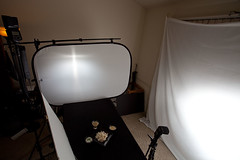 For this shoot I used virtually the same lighting I used for the goat shanks: key light to the right, placed low and bounced off of a sheet, fill light to the rear through a reflector (two stops below the key), secondary fill bounced off the ceiling (three stops below the key), and a piece of white foam core to the left of the dish to provide a bit of added fill. The only real difference in the lighting was the addition of the secondary fill bounced off the ceiling; you can see the effect of that in the photo below where there appears to be a bit of an extra glow to the basil sauce.
For this shoot I used virtually the same lighting I used for the goat shanks: key light to the right, placed low and bounced off of a sheet, fill light to the rear through a reflector (two stops below the key), secondary fill bounced off the ceiling (three stops below the key), and a piece of white foam core to the left of the dish to provide a bit of added fill. The only real difference in the lighting was the addition of the secondary fill bounced off the ceiling; you can see the effect of that in the photo below where there appears to be a bit of an extra glow to the basil sauce.Even though this dish was black on black instead of white on white like the goat shanks, this lighting set up worked extremely well. This might easily become my go-to lighting setup for food photography.
Lessons Learned
I'm really beginning to think the one of the biggest keys to successful food photography is finding a way to bring out the textures of the food. And just as with landscape photography, the key to bringing out textures is a side light placed low to the horizon.
The other key to bringing out the textures in food is to find a way to make the food stand out from its environment (the plates and tabletop). One way to do that is to plate light food on dark plates and dark food on light plates. That isn't always possible, but it certainly helps when it is.
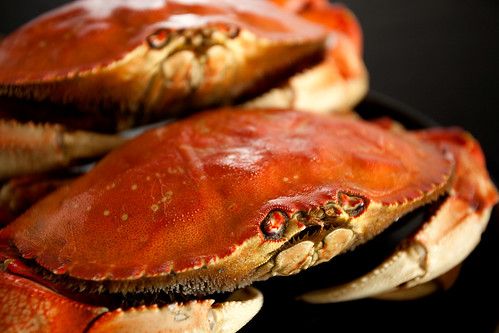
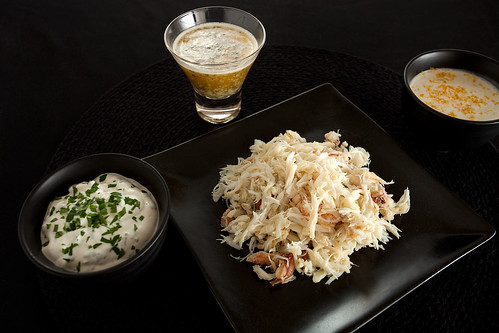
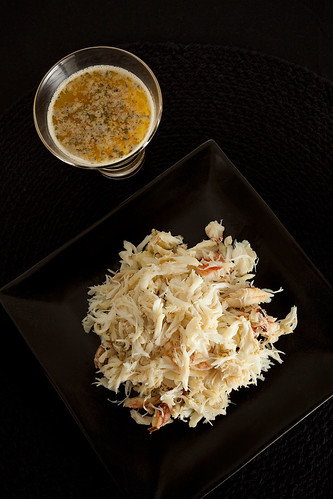
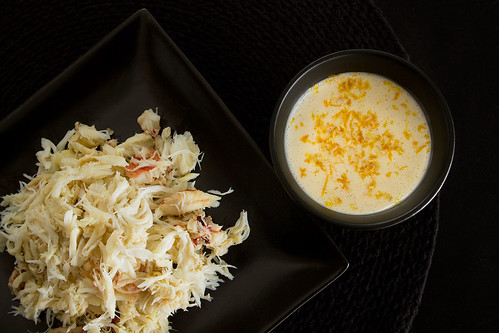
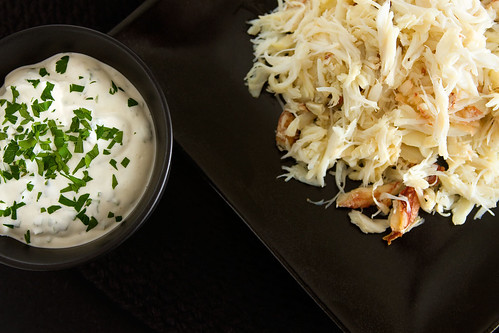
I just stumbled accross your blog and it is so incredibly clever! I saw that your last post was in April, I hope you're still blogging! If not I will enjoy browsing though your past posts. :)
ReplyDeleteThank you this looks delicious going to go try it out!
ReplyDelete